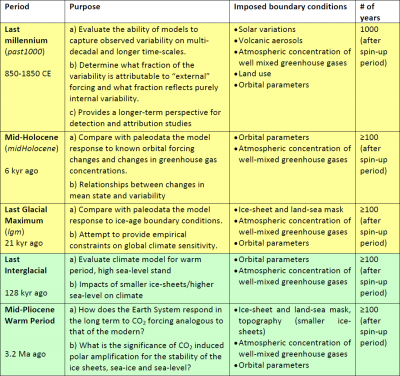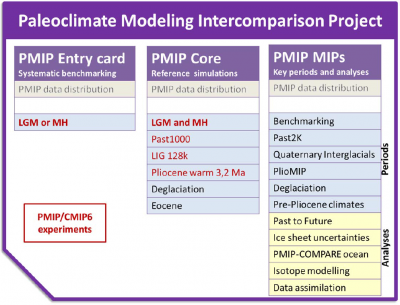This is an old revision of the document!
Table of Contents
PMIP-CMIP6 Experimental Design Discussion: Overview and Prioritization
Please submit your comments in the Discussion section at the end of this page
Overview
The following table summarizes the experiments proposed by PMIP for CMIP6. These experiments all build from the DECK experiments and are part of the core of PMIP simulations (~10), which will themselves constitute a basis for other PMIP experiments (sensitivity analyses, transient simulations starting from the core ones). Within PMIP, each PMIP working group will organize their set of simulations, as PMIP also federates focused MIPs such as PlioMIP on the Pliocene climate, LIGMIP on the Last Interglacial, PAST2K on the last two millennia. For all these periods the model to be used is the same as the one used for future climate projections. Therefore depending on the groups the model will be only atmosphere-ocean coupled models or Earth System models. The reference for the analyses will be the CMIP6 preindustrial simulation.
Table: summary of proposed experiments. In yellow: PMIP3/CMIP5 experiments. In green: new experiments for CMIP6. The PMIP3/CMIP5 experiment names in the ESFG nomenclature are indicated in italic below each period name.
 Click on the table for a bigger version
Click on the table for a bigger version
The next phase of PMIP will make use of the PMIP3 boundary conditions whenever possible. A major foreseen evolution is related to the interactive computation of the dust cycle in atmospheric models, for which changes in vegetation also have to be taken into account. PMIP2 and PMIP3 recommended the use of either interactive vegetation or prescribed pre-industrial vegetation. For PMIP4, those models which include an interactive representation of the dust cycle will have to account for changes in vegetation. We invite the modelling groups to indicate their intentions and opinion about this particular topic in the discussion section at the bottom of this page.
Prioritization
Each proposed PMIP experiment for CMIP6 can be run independently, because they focus on different time periods. The midHolocene and lgm experiments have been the focus of PMIP since its start and allow for an evaluation of new model versions since the first atmosphere-only GCMs in PMIP1. We therefore require one of these two simulations to be performed as an entry card to CMIP6-PMIP4 experiments. All five PMIP experiments proposed for CMIP6 have equal priority, each experiment being the core of a set of sensitivity experiments to be run within PMIP. The organization of the PMIP experiments w.r.t CMIP6 is given in the figure below.
 Click on the figure for a bigger version
Click on the figure for a bigger version
[ PMIP3 Wiki Home ] - [ Help! ] - [ Wiki syntax ]

Discussion
Dear PMIP members,
As I have expressed at the INQUA meeting in Japan, I feel we should improve on the dust representation in the next iteration of PMIP. Let me first address two points that one could make against changing the current setup:
First, it is true that the global effect of dust is modest. The LGM-PI radiative effect has been estimated to around 1 W/m2. However, unlike greenhouse gases, dust is spatially not normally distributed. The global mean, median, and mode are all dominated by low concentrations in the large ocean and polar regions that are very remote from the sources. Because of the spatial log-normality of dust, thinking of its effect in terms of global averages disregards the very high impacts it produces at local to regional scale (which may again have indirect global effects through feedbacks in clouds, vegetation, hydrological cycle etc).
Second, if one looks at dust model results from PMIP2 and 3, there may not be a huge difference between pre-industrial and LGM runs and one could argue that keeping PI conditions is sufficiently accurate. However, this is not consistent with what we know from observational data. From dust flux measurements in marine sediment, loess, ice, and peat cores we know that the LGM climate must have been substantially dustier than the Holocene. In LGM conditions, most models appear to overestimate Saharan sources at the detriment of secondary sources, particularly in East Asia and the Americas. This focus in the models on North Africa may allow them to produce a reasonable global dust radiative forcing, but the neglect of secondary sources may lead to an incorrect representation of indirect effects like iron fertilization of the Southern Ocean, high-latitude cloud cover, etc.
I therefore suggest the following dust design for CMIP6/PMIP4 dust:
A. Models with interactive dust compute it online (no change) B. Models without interactive dust use pre-defined dust concentration: one dataset for PI, Last Millennium, LIG, mid-Pliocene, one for MH, one for LGM
This would lead to two things to be discussed: 1. Do we prescribe source strength for the models with interactive dust (case A)? 2. Which dust datasets do we use for case B?
Concerning 1 I saw a poster at INQUA by Rumi Ohgaito who had greatly improved the MIROC-ESM LGM dust flux simulations by tuning the sources so it seems to be feasible. However, prescribing source strength may lead to unrealistic responses in some models. Please comment on that.
Concerning 2, I have recently published a global dust flux interpolation (128 lon x 64 lat x 12 months x 2 periods) based on observational data (http://dx.doi.org/10.1002/2015GL064250). The dataset includes one interpolation for the LGM and one for PI conditions. I could relatively easily produce an additional interpolation for mid-Holocene conditions. Based on these dust fluxes I can then produce global 3D atmospheric dust concentrations for all three periods using a technique I introduced in my last paper (http://www.nature.com/doifinder/10.1038/nclimate1785). The advantage of the dust flux dataset is that it is completely independent from the models (except for the monthly variation around the yearly mean taken from the models at each grid-point). The atmospheric dust concentration reconstruction uses dry deposition fraction, dry deposition velocity, and vertical concentration profiles from the models (ensemble means/medians) in addition to the dust flux interpolation.
I suggest we use these data (or a variation thereof, depending on what exactly CMIP6 decides on) as dust input for those models that have no interactive dust in the PMIP simulations. Alternatively we could choose one model with interactive dust and use this model’s results as prescribed dust for all the others in case B. In my opinion both options would be an improvement over using PI-dust during the LGM.
The down-side of prescribing dust is that there would be two PI-control runs for each model: One with model-internal dust for future projections, and one with the prescribed dust for past simulations. The advantage would be that the past climate simulations would be more realistic.
Please share your thoughts on this matter. I will upload my INQUA presentation that illustrate the points made above if I figure out how to do this.
Thanks, Fabrice
I got to see some pmip folks at the ITCZ meeting in New York last week.
I think that it is important to maintain continuity from PMIP3. But, I do think that we should improve boundary conditions where possible. One component in need of improvement is the land surface. Otherwise, modern vegetation will leave its decidedly modern imprint on all of our simulations.
I would like to have vegetation masks for the simulations. These could be paired with 'confidence masks' to deal with the uncertainty of designing such a product. Especially after seeing the impact of having vegetation in the Sahel/Sahara region to maintain rainfall in this region, I think it is important. And, formalizing it through pmip might avoid having random modeling groups just coming up with their own disparate masks. ( :) )
Also, since this is a discussion wish-list, paleo maps for other earth system components, like dust emissions, would be neat.
The experimental design does not currently appear to say anything about ensemble sizes.
For the mid-Holocene, LGM, Last Interglacial and mid-Pliocene experiments, this is not an issue. These are snapshot experiments, and so the signal-to-noise ratio can be improved simply by running longer simulations. However, the Last Millennium experiment is fundamentally different here as: (i) it is a transient simulation, and (ii) it is simulating a period when internal variability can dominate over any response to external forcings.
I'll make further comments on the Last Millennium on the dedicated page for that experiment. However, the experimental design should make recommendations in regard to ensemble sizes for all experiments, particularly as it is becoming increasingly common to run multi-member ensembles for individual models.